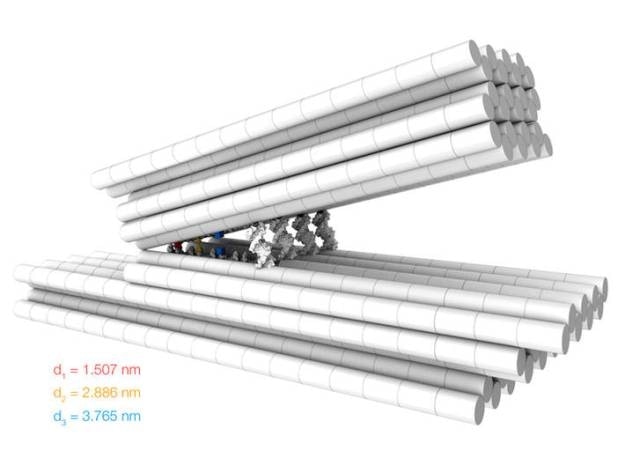Mar 7 2016
A team of researchers from the Technical University of Munich (TUM) have used DNA to develop two innovative nanoscale machines containing moving parts. In this technique, DNA was used as a self-assembling and programmable construction material.
 Molecular manipulator made from DNA. Dietz Lab/TUM
Molecular manipulator made from DNA. Dietz Lab/TUM
The scientists published their study in the Science Advances journal, where they described a rotor mechanism assembled from interlocking 3D DNA components. Yet another paper published in Nature Nanotechnology, described a hinged molecular manipulator that was also designed from DNA. These advancements are some of the innovative steps developed in a campaign that aims to redefine DNA origami into a commercially feasible technology that can be used in industries.
Physicists working in Professor Hendrik Dietz's lab at TUM developed the new nanoscale machines by taking their cue from nature's nanomachines, such as the motor-driven flagella of bacterium and the ATP enzyme. The research team continues to extend its own design and development repertoire, and have developed rules and procedures to produce self-assembled DNA origami structures with much more control and flexibility. The physicists toolkit has gradually advanced towards a higher level of modular assembly and programming, transitioning from matching of DNA basepair, to shape-complementary building methods using different types of interlocking bricks.
In addition to this advancement, the researchers have refined techniques to validate whether a specific soup of nanoparticles is actually packed with, for instance; copies of an artificial membrane channel, a switchable gear, a randomly complicated test object, a robot with movable arms, a nanobook that closes and opens, or similar other designs.
Two new additions to the zoo
Two small 3D machines with moving parts are the new additions to the lab's collection of DNA origami objects, highlighting new capabilities.
Elena Willner and Philip Ketterer, both doctoral candidates, teamed up with Dietz to construct a unique rotary mechanism using three multilayer DNA building blocks such as; a longer lever-like extension, a rotor unit with a body measuring 32 nm in length, and a couple of clamp elements that fuse together to create an axle bearing. The parts fuse with a tight fit, leaving just 2 nm of play around the axle bearing. This enables the rotor to swing but not to shake. In one model the arm freely rotates between arbitrary stopping points, and in another version the arm remains in specified positions called docking sites. To date, this is considered to be the most complicated rotary structure ever produced with DNA origami methods. The rotor does not have a motor and is driven by Brownian motion, which refers to the arbitrary movement of particles suspended in solution.
The viability of developing such a machine indeed paves the way for developing active devices under thermal or chemical power and control.
It’s like having built an engine. Now spark plugs and combustible fuel are the next items on the to-do list.
Professor Hendrik Dietz, Physics, Technical University of Munich
In another project a hinged machine was produced by Dietz and Jonas Funke, a doctoral candidate. The machine was developed on a scale suitable so that separate molecules can be exploited with atomic accuracy. DNA helices can be used to regulate the angle between the two key structural elements of the gripper. When this DNA origami positioning device was tested, it was revealed that this machine could accurately place molecules, altering the distance between the molecules in steps down to the radius of a hydrogen atom. This latest study shows promise to create larger DNA origami devices without compromising the limits of accuracy. The study results also indicate that DNA nanomachines could someday prove useful for controlling chemical reactions in the future.
On the one hand,we now really trust the placement precision within our structures – because we have actually placed two molecules and controlled their distance with atomic precision. On the other hand we have now a prototype rotary mechanism. Based on our measurements, its mobility is such that it could do up to 50,000 rpm if every rotary step it took would go only in one direction. In the next generation of devices, we will use the placement precision to couple chemical reactions to the movements of a rotor. This has the potential to result in a motor. This device, then, could be used for all kinds of purposes, such as actively propelling nanoscale drug-delivery vehicles, pumping and separating molecules across barriers, or packaging molecules into cargo compartments.
Professor Hendrik Dietz, Physics, Technical University of Munich
This study was funded by the German Research Foundation (DFG) through Excellence Clusters CIPSM and NIM as well as Collaborative Research Center (SFB) 863; the European Research Council (Starting Grant to H.D.); the TUM International Graduate School for Science and Engineering; and the German-Israeli Project Cooperation.